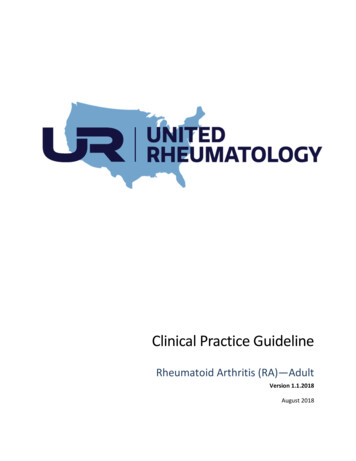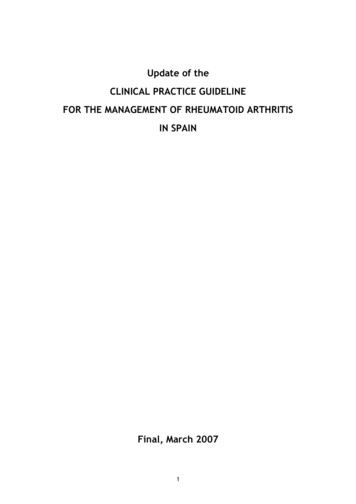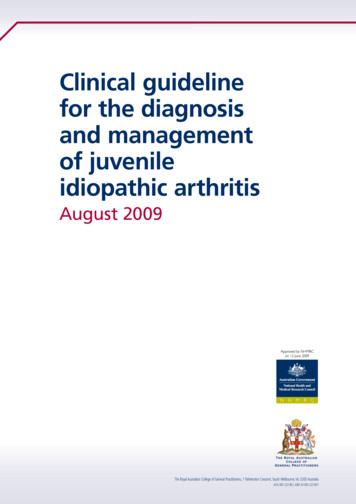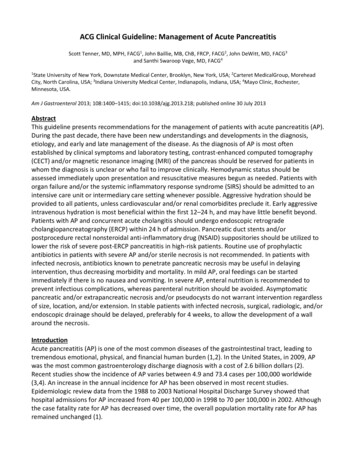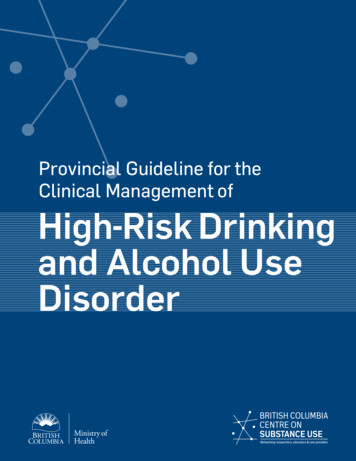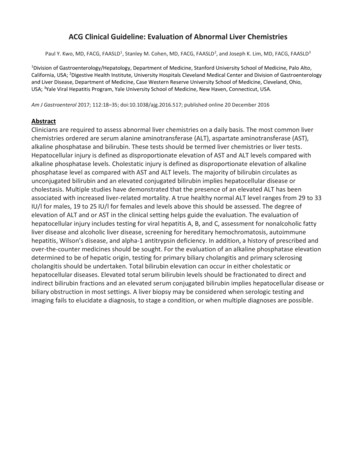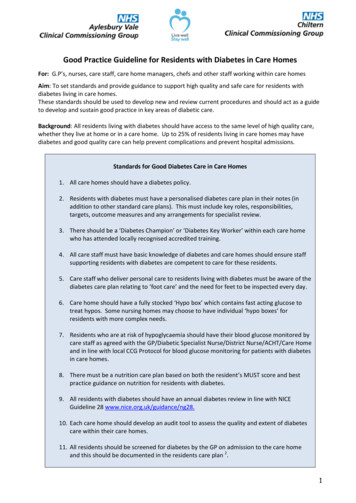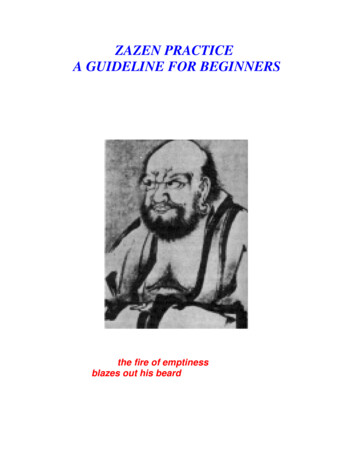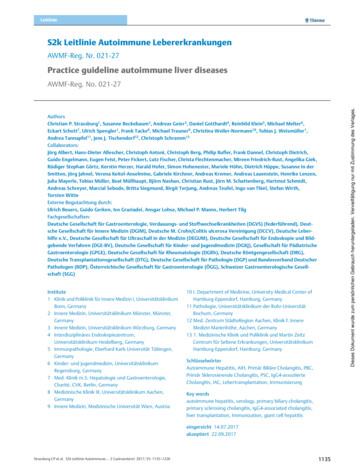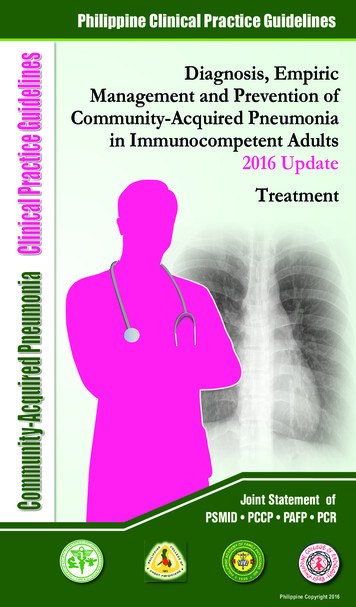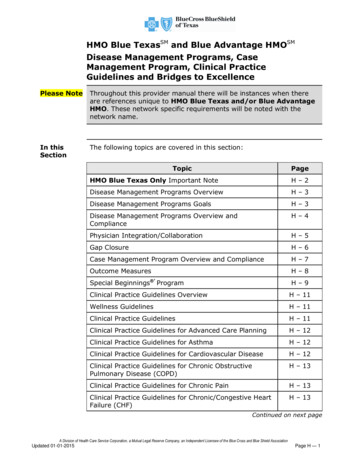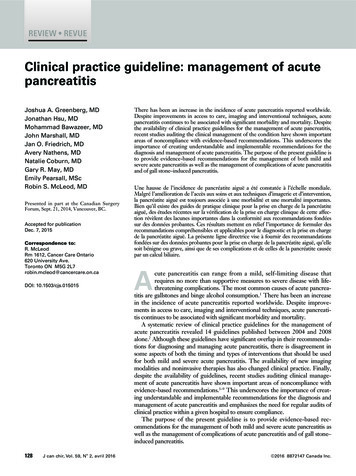
Transcription
REVIEW REVUEClinical practice guideline: management of acutepancreatitisJoshua A. Greenberg, MDJonathan Hsu, MDMohammad Bawazeer, MDJohn Marshall, MDJan O. Friedrich, MDAvery Nathens, MDNatalie Coburn, MDGary R. May, MDEmily Pearsall, MScRobin S. McLeod, MDPresented in part at the Canadian SurgeryForum, Sept. 21, 2014, Vancouver, BC.Accepted for publicationDec. 7, 2015Correspondence to:R. McLeodRm 1612, Cancer Care Ontario620 University Ave.Toronto ON M5G 2L7robin.mcleod@cancercare.on.caDOI: 10.1503/cjs.015015128oJ can chir, Vol. 59, N 2, avril 2016There has been an increase in the incidence of acute pancreatitis reported worldwide.Despite improvements in access to care, imaging and interventional techniques, acutepancreatitis continues to be associated with significant morbidity and mortality. Despitethe availability of clinical practice guidelines for the management of acute pancreatitis,recent studies auditing the clinical management of the condition have shown importantareas of noncompliance with evidence-based recommendations. This underscores theimportance of creating understandable and implementable recommendations for thediagnosis and management of acute pancreatitis. The purpose of the present guideline isto provide evidence-based recommendations for the management of both mild andsevere acute pancreatitis as well as the management of complications of acute pancreatitisand of gall stone–induced pancreatitis.Une hausse de l’incidence de pancréatite aiguë a été constatée à l’échelle mondiale.Malgré l’amélioration de l’accès aux soins et aux techniques d’imagerie et d’intervention,la pancréatite aiguë est toujours associée à une morbidité et une mortalité importantes.Bien qu’il existe des guides de pratique clinique pour la prise en charge de la pancréatiteaiguë, des études récentes sur la vérification de la prise en charge clinique de cette affection révèlent des lacunes importantes dans la conformité aux recommandations fondéessur des données probantes. Ces résultats mettent en relief l’importance de formuler desrecommandations compréhensibles et applicables pour le diagnostic et la prise en chargede la pancréatite aiguë. La présente ligne directrice vise à fournir des recommandationsfondées sur des données probantes pour la prise en charge de la pancréatite aiguë, qu’ellesoit bénigne ou grave, ainsi que de ses complications et de celles de la pancréatite causéepar un calcul biliaire.Acute pancreatitis can range from a mild, self-limiting disease thatrequires no more than supportive measures to severe disease with lifethreatening complications. The most common causes of acute pan crea titis are gallstones and binge alcohol consumption.1 There has been an increasein the incidence of acute pancreatitis reported worldwide. Despite improvements in access to care, imaging and interventional techniques, acute pancreatitis continues to be associated with significant morbidity and mortality.A systematic review of clinical practice guidelines for the management ofacute pancreatitis revealed 14 guidelines published between 2004 and 2008alone.2 Although these guidelines have significant overlap in their recommendations for diagnosing and managing acute pancreatitis, there is disagreement insome aspects of both the timing and types of interventions that should be usedfor both mild and severe acute pancreatitis. The availability of new imagingmodalities and noninvasive therapies has also changed clinical practice. Finally,despite the availability of guidelines, recent studies auditing clinical management of acute pancreatitis have shown important areas of noncompliance withevidence-based recommendations.3–9 This underscores the importance of creating understandable and implementable recommendations for the diagnosis andmanagement of acute pancreatitis and emphasizes the need for regular audits ofclinical practice within a given hospital to ensure compliance.The purpose of the present guideline is to provide evidence-based rec ommendations for the management of both mild and severe acute pancreatitis aswell as the management of complications of acute pancreatitis and of gall stone–induced pancreatitis. 2016 8872147 Canada Inc.
REVIEWMethodologyThe guideline was developed under the auspices of theBest Practice in General Surgery group at the Universityof Toronto. Best Practice in General Surgery is a qualityinitiative aimed to provide standardized evidence-basedcare to all general surgery patients treated at the University of Toronto adult teaching hospitals. A workinggroup consisting of general surgeons, critical care intensivists and a gastroenterologist led the development ofthese recommendations. The working group establishedthe research questions, the analytical framework andclinically relevant outcomes for the guideline. The recommendations pertain to patients with a new presentation of suspected acute pancreatitis. Primary outcomesare complications, both infectious and noninfectious;mortality; length of hospital stay; and readmissions associated with acute pancreatitis. Definitions of key termswere based on the 2012 Atlanta Classification of AcutePancreatitis10 (Box 1).Initially, we performed a scoping review to identifyclin ical practice guidelines related to the managementof acute pancreatitis. We then searched Medline forguidelines published between 2002 and 2014 using theMedical Subject Headings “pancreatitis” and “clinicalpractice guideline.” This search identified 14 guideBox 1. Definitions of key terms (based on the 2012 AtlantaClassification of Acute Pancreatitis10)Diagnosis of acute pancreatitis (2 of the following) Abdominal pain (acute onset of a persistent, severe, epigastric pain oftenradiating to the back) Serum lipase activity (or amylase) at least 3 times greater than the upperlimit of normal Characteristic findings of acute pancreatitis on computed tomography ormagnetic resonance imagingMild acute pancreatitis No organ failure, local or systemic complicationsModerately severe acute pancreatitis Organ failure that resolves within 48 h and/or Local or systemic complications without persistent organ failureSevere acute pancreatitis Persistent organ failure 48 hInterstitial edematous acute pancreatitis Acute inflammation of the pancreatic parenchyma and peri-pancreatictissues, but without recognizable tissue necrosisNecrotizing acute pancreatitis Inflammation associated with pancreatic parenchymal necrosis and/orperi-pancreatic necrosisOrgan failure and systemic complications of acute pancreatitis Respiratory: Pao2/FiO2 300 Cardiovascular: systolic blood pressure 90 mm Hg (off inotropic support),not fluid responsive, or pH 7.3 Renal: serum creatinine 170 mmol/LLocal complications of acute pancreatitis Acute peripancreatic fluid collections Pancreatic pseudocysts Acute necrotic collections Walled-off pancreatic necrosislines published between 2008 and 2014. A 2010 systematic review of acute pancreatitis clinical practiceguidelines that included all of the most recent guidelines was identified.2Another electronic search of Medline was performedusing the Medical Subject Headings “pancreatitis,”“acute necrotizing pancreatitis,” “alcoholic pancrea titis,” and “practice guidelines” to update the systematicreview. The results were limited to articles published inEnglish between January 2007 and January 2014. Thereferences of relevant guidelines were reviewed. Up-todate articles on acute pancreatitis diagnosis and management were also reviewed for their references11 (as ofJanuary 2014).The working group developed the guideline recommendations based on evidence as well as consensus. Then theguideline recommendations were circulated to all generalsurgeons, gastroenterologists and critical care intensivists atthe University of Toronto for feedback.Guideline recommendationsTable 1 summarizes the guideline recommendations andgrading.1. Diagnosis of acute pancreatitis1.1 A serum lipase test should be performed in allpatients with a suspected diagnosis of acute pan creatitis. A 3-fold elevation of serum lipase from theupper limit of normal is required to make the diagnosis of acute pancreatitis.1.2 Ultrasonography should be performed in all patientsat baseline to evaluate the biliary tract and in par ticular to determine if the patient has gallstonesand/or a stone in the common bile duct (CBD).1.3 Magnetic resonance cholangiopancreatography(MRCP) is recommended only in patients in whomthere is elevation of liver enzymes and in whom theCBD is either not visualized adequately or is foundto be normal on ultrasound.1.4 Computed tomography (CT) should be performedselectively when 1) a patient presents with substantial abdominal pain and a broad differential diagnosis that includes acute pancreatitis, or 2) in patientswith suspected local complications of acute pan crea titis (e.g., peritonitis, signs of shock, suggestiveultrasound findings). Computed tomography forthe assessment of local complications is most useful48–72 hours after the onset of symptoms ratherthan at the time of admission. Unless contraindicated (e.g., renal dysfunction), intravenous contrastshould be given in order to assess for pancreaticnecrosis once patients are adequately fluid resuscitated and normovolemia is restored.Can J Surg, Vol. 59, No. 2, April 2016129
REVUETable 1. Summary and grading of recommendationsGuideline recommendationStrength of evidenceGuideline recommendationModerate–highStrongUltrasonography should be performed in all patients at baseline to evaluate the biliary tract todetermine if the patient has gallstones and/or a stone in the common bile duct.HighStrongMagnetic resonance cholangiopancreatography (MRCP) is recommended only in patients inwhom there is elevation of liver enzymes and the common bile duct is either not visualizedadequately or is found to be normal on ultrasound.HighStrongComputed tomography should be performed selectively when 1) a broad differential diagnosisthat includes acute pancreatitis must be narrowed, or 2) in patients with acute pancreatitis anda suspected local complication (e.g., peritonitis, signs of shock, suggestive ultrasound findings).Low–moderateStrongC-reactive protein (CRP) should be assessed at admission and daily for the first 72 h after admission.Low–moderateWeakAcute Physiologic Assessment and Chronic Health Evaluation (APACHE) II Scores should becalculated on admission and daily for the first 72 h after admission.ModerateWeakThe diagnosis of severe acute pancreatitis should be made if the patient has a serum CRP 14 286 nmol/L (150 mg/dL) at baseline or in the first 72 h; APACHE Score 8 at baseline or inthe first 72 h; or exhibits signs of persistent organ failure for 48 h despite adequate intravenousfluid resuscitation.ModerateStrongSupportive care, including resuscitation with isotonic intravenous fluids like Ringer’s Lactate, paincontrol and mobilization, should be the mainstay of treatment for patients with mild acute pancreatitis.LowStrongCareful consideration of transfer to a monitored unit should be made in patients with Severe acute pancreatitis based on APACHE II Score 8, CRP 14 286 nmol/L (150 mg/dL),or organ dysfunction 48 h despite adequate resuscitation; Evidence of present or evolving organ dysfunction; Need for aggressive, ongoing fluid resuscitation.LowStrongPatients with mild acute pancreatitis should receive a regular diet on admission. If patients initially areunable to tolerate an oral diet owing to abdominal pain, nausea, vomiting, or ileus, they may beallowed to self-advance their diet from withholding oral food and liquid to a regular diet as tolerated.HighStrongIn patients with severe acute pancreatitis, enteral nutrition should be commenced as soon aspossible following admission (within 48 h).HighStrongA serum lipase test should be performed in all patients with a suspected diagnosis of acutepancreatitis.Prophylactic antibiotics are not recommended.HighStrongPatients with 1) extensive necrotizing acute pancreatitis, 2) who show no clinical signs ofimprovement following appropriate initial management, or 3) who experience other complicationsshould be managed in institutions that have on-site or access to therapeutic endoscopy, interventionalradiology, surgeons and intensivists with expertise in dealing with severe acute pancreatitis.ModerateWeakFollow-up computed tomography should be based on the clinical status of the patient and notperformed routinely at regular intervals.LowStrongPatients with acute peripancreatic fluid collections with no radiological or clinical suspicion ofsepsis should be observed, and image-guided fine needle aspiration (FNA) should be avoidedowing to the risk of introducing infection into a sterile collection.ModerateWeakWhen there is radiological or clinical suspicion of infected necrosis in patients with acute necroticcollections (ANCs) or walled-off pancreatic necrosis (WOPN), image-guided FNA with cultureshould be performed to distinguish infected from sterile necrosis.ModerateStrongSterile necrosis based on negative FNA and/or stable clinical picture should be managednonoperatively, and antibiotics are not indicated. For unstable patients in whom sepsis issuspected but no source has been identified, treatment with broad spectrum antibiotics onspeculation may be indicated while an appropriate work up (bacterial and fungal cultures, CTscan) is carried out.ModerateWeakIn patients with FNA-confirmed infections of ANCs or WOPN, a step-up approach of antibiotics,image-guided drainage, followed by surgical intervention, if necessary, is indicated.ModerateStrongPancreatic pseudocysts that are asymptomatic should be managed nonoperatively. Interventionis indicated in pseudocysts that are symptomatic, infected, or increasing in size on serial imaging.ModerateStrongEndoscopic retrograde cholangiopancreatography (ERCP) should be performed early (within 24–48 h) in patients with acute gallstone pancreatitis assoc
cute pancreatitis can range from a mild, self-limiting disease that requires no more than supportive measures to severe disease with life-threatening complications. The most common causes of acute pancrea- titis are gallstones and binge alcohol consumption.1 There has been an increase in the incidence of acute pancreatitis reported worldwide. Despite improve-
